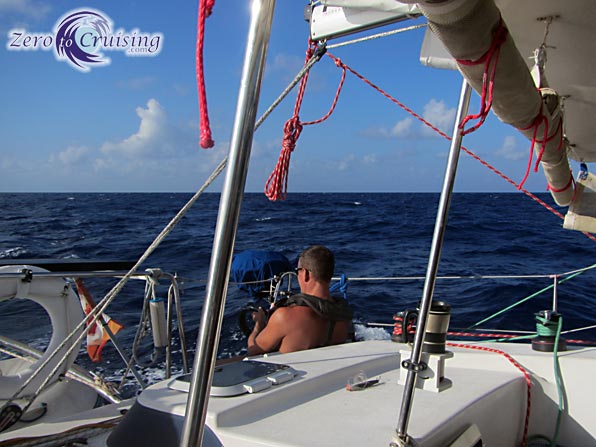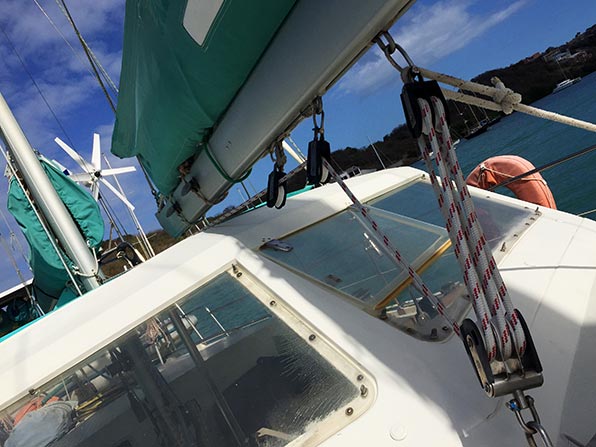Brace, brake, or preventer: Controlling the gybe
Unlike racers who regularly have downwind legs in their courses, or ocean sailors following the Coconut Milk Run, those of us who transited the Thorny Path south to the Caribbean, and regularly sail the windwards and leewards, don’t get that much opportunity to sail off the wind. In fact, I would say hardly ever, especially if we’re talking about true downwind sailing. The fact is, when Rebecca and I sailed on Two Fish from Panama to the Galapagos, that was the most downwind sailing that we had ever done!
On the rare occasions that we did find ourselves sailing on a broad reach or deeper, we normally rigged some form of preventer to the boom, especially if we were going to be on that tack for any period of time. I used the phrase “some form” to describe what we did because using the definitions below, it was not a true preventer at all.
It seems to me that there are several ways people control the boom when sailing downwind:
Preventer: A line typically rigged from the end of the boom* forward to the bow, and then back to the cockpit. Properly tensioned, this can help to prevent an accidental gybe.
Read about some preventer difficulties that our friends on Distant Shores had not too long ago.
Brace/Tackle: A line from the end of the boom to the toe rail, or to a cleat. This may control some of the movement of the boom, but due to its angle, may not prevent a gybe.
We found that our friends on Two Fish frequently used a brace line to control the banging of the boom in light air and sloppy seas. I read that this line chafed though on one of their longer passages, requiring it to be replaced.
Boom Brake: Although there are different types, at least one device is similar to a rock climber’s figure 8 descender. It is attached to the boom close to the boom vang, and when the line running through it is tensioned, it creates friction, slowing/controlling the swing of the boom during gybes.

A couple of figure 8 descenders that I happen to have on board.
Here is an article that I found on Google where several of the commercially available boom brakes are compared.
Using the above definitions, what we normally rigged on ZTC was somewhere between a brace and a preventer. We would run a line from the end of the boom to a midship cleat, but we typically did not have it set up so that we could tension it with a winch, or control it from the cockpit. To set it, or release it, we would need to go forward to the cleat each time.

Contrary to what I wrote above, in this case, the red line, the preventer, has actually been lead back to a winch.
I’ve been giving this quite a bit of thought lately. There are several excellent articles on the Attainable Adventure Cruising website describing the set-up and usage of a good preventer system. There is also another article on that site singing the praises of a boom brake (although it does offer some critique of them as well). To view those articles you’ll need to pay for a membership, something that I do, and obviously feel is worthwhile.
One question I have with respect to our particular boat relates to where the preventer is best attached to the boom. On our main boom, the mainsheet attaches quite a bit forward from the end. If the preventer is attached to the very end of the boom and tensioned hard, a large horizontal bending force would be created.

Should the preventer be set at the end of the boom, or closer to the mainsheet attachment? I’ve queried other Amel owners to find out what they do.
As there are only two main winches in our cockpit, and one small one normally reserved for furling the genoa, tensioning a preventer, or a boom brake, would be difficult without some additional hardware (clutches). Because of that, I’d like to have this well thought out before we start spending money and drilling holes!



FYI, I believe that Beth and Evans have a pretty good preventer system described either at their website or in their Voyager’s Handbook….. can’t remember which.
Once you get that sorted, you can move on to barber haulers 🙂
I’ll check that. Thank you!
As for Barber Haulers, we had one rigged for a time on Two Fish. 🙂
I found a link where they describe their set-up:
http://www.bethandevans.com/seamanship.htm#34
It sounds similar to the one shown on the AAC site.
We use the factory-original Amel preventers (consisting of lines, blocks, and cam cleats built into the block closest to the cockpit). Controlled from inside the cockpit. No drilling.
The only limitation on the Amel factory-supplied preventers is that there is only one for the main and one for the mizzen. So last year we duplicated the system and now the system is deployed more or less permanently, usually loose, tensioned on the lee side only when there is the slightest chance of a gybe, or to reduce sail banging in little wind.
When I searched the Amel Yahoo group I found references to this. Unfortunately, no such system came with our boat. I’d love to see some pics of what you’re referring to.
Another thing worth considering is whether traveler and mainsheet (any boomed sail) tackles should be polyester or nylon. I switched my traveler line to 8mm climbing rope several years ago and couldn’t be happier. There are a number of well-known riggers that suggest nylon for cruising travelers.
I way well stitch my mainsheet over as well when it is due in a few years. I haven’t decided. The traveler line is hand-tensioned, so stretch under sailing loads is nothing, but the main sheet is winched. I may add a block to reduce the load, and then go to nylon.
That is an extra issue for us as we do not have an adjustable traveller. Both the main and mizzen are on tracks adjustable only by moving a pin, similar to a jib car track. There is NO stretch in the system.
Then I would think about nylon sheets. There is not much length, there is a 4:1 tackle, and gear breakage probably matters more than the perfect tweaking of twist. Plus, a little stretch in the sheet open the leach a little in the puffs, which is not a bad thing.
I’m all for preventers and everything else you discussed. This is just one more thing that I have found useful.
I would not use nylon for genoa sheets, preventers, or other control lines. Just boomed-sail sheets and travelers, where there is impact.
I agree.